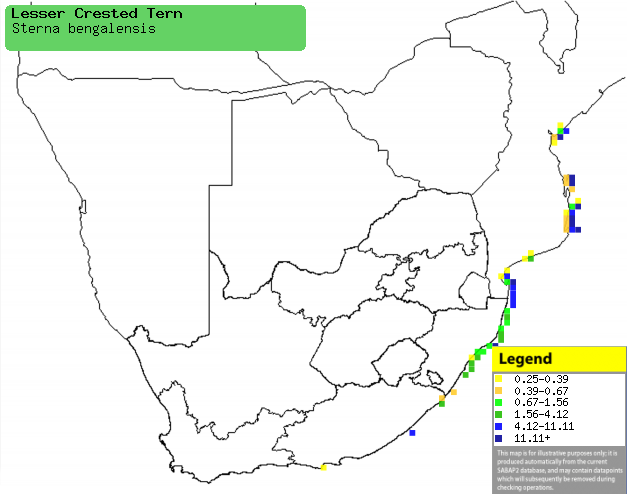|
Sterna bengalensis (Lesser
crested tern)
Kuifkopsterretjie [Afrikaans]; Bengaalse stern [Dutch];
Sterne voyageuse [French]; Rüppell-seeschwalbe [German];
Gaivina-de-bico-laranja [Portuguese] Life
> Eukaryotes >
Opisthokonta
> Metazoa (animals) >
Bilateria >
Deuterostomia > Chordata >
Craniata > Vertebrata (vertebrates) > Gnathostomata (jawed
vertebrates) > Teleostomi (teleost fish) > Osteichthyes (bony fish) > Class:
Sarcopterygii (lobe-finned
fish) > Stegocephalia (terrestrial
vertebrates) > Tetrapoda
(four-legged vertebrates) > Reptiliomorpha > Amniota >
Reptilia (reptiles) >
Romeriida > Diapsida > Archosauromorpha > Archosauria >
Dinosauria
(dinosaurs) > Saurischia > Theropoda (bipedal predatory dinosaurs) >
Coelurosauria > Maniraptora > Aves
(birds) > Order: Charadriiformes
> Family: Laridae > Genus: Sterna
Distribution and habitat
Breeds in tropical and sub-tropical areas, especially
Australasia and in the southern Mediterranean; in the non-breeding season
it mainly stays within these areas, although some head south to the eastern
coast of Africa. In southern Africa it is
uncommon to locally common along the coast of Mozambique, KwaZulu-Natal and the
Eastern Cape, generally preferring sandy coasts with coral, estuaries and
coastal lagoons.
|
 |
|
Distribution of Lesser crested tern in southern Africa,
based on statistical smoothing of the records from first SA Bird Atlas
Project (©
Animal Demography unit, University of
Cape Town; smoothing by Birgit Erni and Francesca Little). Colours range
from dark blue (most common) through to yellow (least common).
See here for the latest distribution
from the SABAP2. |
Movements and migrations
Non-breeding summer visitor to southern Africa,
probably originating from the Red Sea, arriving in southern Africa in the
period from October-December. It leaves between January and June,
although individuals occasionally stay over winter.
Food
Almost exclusively eats fish, supplemented with cephalopods
and crustaceans, doing most of its foraging less than 6 km from the shore,
mainly on incoming and high tides at mid-morning or late afternoon.
Threats
Not threatened.
References
-
Hockey PAR, Dean WRJ and Ryan PG 2005. Roberts
- Birds of southern Africa, VIIth ed. The Trustees of the John Voelcker
Bird Book Fund, Cape Town.
|
